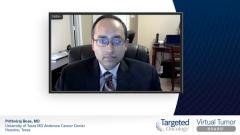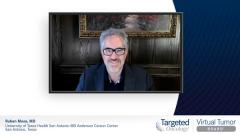
Case 1: Treatment Approaches for High Risk P. Vera
Prithviraj Bose, MD, and colleagues discuss treatment options for high risk polycythemia vera.
Episodes in this series

Prithviraj Bose, MD: NCCN [National Comprehensive Cancer Network] Guidelines exist for high-risk disease, meaning patients who are either 60 years of age or older or have a prior clot. As we’ve been discussing, hydroxyurea represents the mainstay of frontline therapy across most of the world, but pegylated interferon alfa is a decent option as well. There was a trial by the MPN [Myeloproliferative Neoplasms Research] Consortium showing no difference. Ropeginterferon alfa-2b is approved in Europe and another frontline option there. Of course, you monitor these patients and see if they need second-line therapy. Pretty much the same things we went over with low-risk patients as a possible indicator for cytoreduction would apply here to see if somebody needs second-line therapy. As Jamile [Shammo] pointed out, the approved option would be ruxolitinib, although there are data for pegylated interferon alfa as well.
Ruxolitinib was approved based on the RESPONSE and RESPONSE-2 trials. RESPONSE was a phase 3 trial in hydroxyurea-resistant or -intolerant patients. About 220 patients were randomized 1:1 to ruxolitinib or best-available therapy [BAT]. These patients had to have splenomegaly. The primary end point was a composite of hematocrit control and spleen volume reduction. You could cross over at week 32. There was an initial phase where the hematocrit was controlled for all patients to serve as a level playing field before the randomization occurred.
Recently, we learned from the 5-year follow-up from this pivotal trial that you saw a sustained duration of action of the drug with no new safety signals. Essentially, the probability of maintaining that primary end point was 74% after 5 years. This was about 55% for the CHR [complete hematologic remission] attainment and maintenance of the CHR. It was 67% at 5 years for the overall clinical hematologic response.
There were minimal adverse effects, the ones you would typically expect with ruxolitinib. Importantly, thromboembolic events were looked at as a toxicity measure and not as an efficacy end point. At 5 years of follow-up, the rate was 8.2 in the BAT group, 1.2 in the ruxolitinib group, and a little higher in the ruxolitinib crossover group.
RESPONSE-2 was done in Europe. It was a phase 3B study designed very similarly, except that these patients did not have any palpable splenomegaly. They were also randomized to ruxolitinib or best available therapy 1:1. It was a slightly smaller study, with about 150 patients. Obviously, the spleen was not an issue, so the primary end point was hematocrit control, this time at week 28. The baseline characteristics were fairly similar and well balanced across the arms. I’ll skip over that in the interest of time.
The results were actually very similar to those of RESPONSE. There were strikingly similar percentages for the hematocrit control, CHR rate, and symptom response. This trial also has 5 years of follow-up. This was shown at ASH [American Society of Hematology Annual Meeting] 2020. You saw fairly sustained hematocrit control, which was the primary end point. About 22% of the patients were maintaining that at 5 years. Strikingly, in terms of symptoms, the same 45% that you saw at week 28 maintained that response. The symptom response at 5 years compared with 16% with the best-available therapy. Phlebotomies throughout the 260 weeks were reduced, and the need for phlebotomy was reduced in the ruxolitinib arm.
Adverse effects are important to mention. The usual things that we are familiar with, with our use of this drug in myelofibrosis, are things like weight gain, a little anemia, headaches, dizziness, and bruising. Herpes zoster and nonmelanoma skin cancer are 2 important nonhematologic adverse effects to be aware of, particularly in the PV [polycythemia vera] population. The nonmelanoma skin cancer is especially relevant if they had prior nonmelanoma cancer. As I said before, these RESPONSE trials were not powered for thromboembolic events as an efficacy end point but by looking at that them as an adverse effect. You saw a lower rate in the ruxolitinib at 5 years in response to 1.5%, 3.7% in the BAT arm, and 2.9% in the ruxolitinib crossover patients.
This transcript was edited for clarity.











































